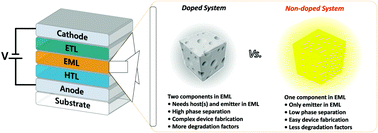Recent breakthroughs in thermally activated delayed fluorescence organic light emitting diodes containing non-doped emitting layers
Abstract
Thermally activated delayed fluorescence (TADF) materials have attracted significant attention owing to their state-of-the-art performance in the field of organic light-emitting diodes (OLEDs). TADF materials have the capability of harvesting both singlet and triplet excitons through reverse intersystem crossing, thus, the maximum internal quantum efficiency can be expected to be 100%. Thanks to TADF materials that are developed from pure organic entities so that they are inexpensive and external quantum efficiencies as high as 38% have been achieved to date. Despite the high performance of doped OLEDs, precise control of the host–guest ratio and phase separation at high driving voltages are the foremost challenges. In order to circumvent these demerits, the use of numerous small molecules, dendritic molecules, and polymers as non-doped emitters has been reported. Non-doped OLEDs consist of only a single molecule emitter in the emissive layer, thus simplifying the device fabrication process. Furthermore, non-doped OLEDs exhibit better device stability compared to doped devices, because the former do not exhibit phase separation or crystallinity and maintain a homogeneous surface film morphology during device operation. As a result, non-doped OLEDs are capable of overcoming the most pivotal issues of device complexity and stability, which makes them effective in rendering OLEDs commercially viable. Although maximum external quantum efficiencies of nearly 23.0% in blue, 22.0% in green, 22.0% in yellow, 17.0% in orange, and 10.0% in red emitting materials have been realized with non-doped OLEDs, still further progress is essential to reach the doped devices. This review systematically describes the molecular design, photophysical properties, and electroluminescence performance data of non-doped TADF emitters. We strongly believe that this review will be beneficial in terms of presenting a specific direction for the design of a variety of non-doped TADF emitters in the near future.

- This article is part of the themed collection: Recent Review Articles


 Please wait while we load your content...
Please wait while we load your content...